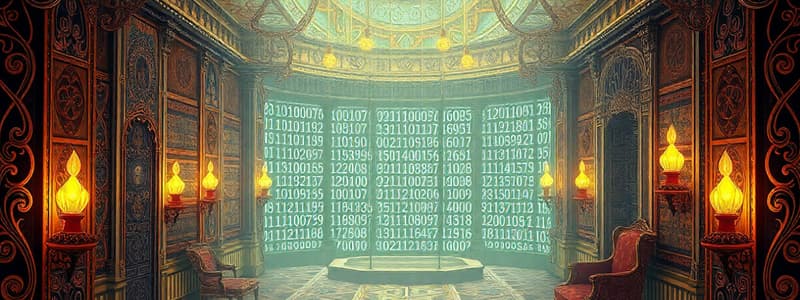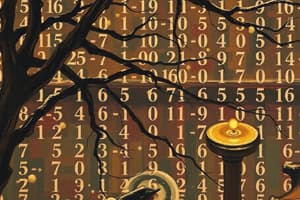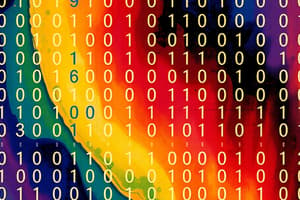Podcast
Questions and Answers
What is the primary advantage of using the binary number system in digital systems?
What is the primary advantage of using the binary number system in digital systems?
- It enables the storage of a wider range of numerical values.
- It simplifies the representation of numerical values for physical parameters. (correct)
- It allows for complex mathematical calculations to be performed more efficiently.
- It makes it easier to read and interpret the data.
In a binary number, what determines the weight of each bit?
In a binary number, what determines the weight of each bit?
- The number of bits in the binary number.
- The value of the bit (0 or 1).
- The position of the bit, represented as a power of 2. (correct)
- The significance of the bit, based on its proximity to the MSB.
How is the decimal equivalent of the binary number 101101 calculated?
How is the decimal equivalent of the binary number 101101 calculated?
- By multiplying each bit by its corresponding power of 2 and summing the results. (correct)
- By counting the number of 1s in the binary number.
- By adding the bit values together.
- By multiplying each bit by its position number and summing the results.
When converting a decimal number to its binary equivalent using the division method, what does the first remainder represent?
When converting a decimal number to its binary equivalent using the division method, what does the first remainder represent?
What is a primary disadvantage of using binary numbers when representing large decimal values?
What is a primary disadvantage of using binary numbers when representing large decimal values?
What is the hexadecimal number system primarily used for in computing?
What is the hexadecimal number system primarily used for in computing?
How many binary digits are combined to form a single hexadecimal digit?
How many binary digits are combined to form a single hexadecimal digit?
Why is the hexadecimal system base 16 more efficient than the binary system base 2 in computing?
Why is the hexadecimal system base 16 more efficient than the binary system base 2 in computing?
If a binary number does not have a multiple of four bits, how is it converted to hexadecimal?
If a binary number does not have a multiple of four bits, how is it converted to hexadecimal?
In the hexadecimal system, what do the letters A through F represent?
In the hexadecimal system, what do the letters A through F represent?
How does the octal number system relate to the binary number system?
How does the octal number system relate to the binary number system?
What is the primary advantage of using octal or hexadecimal numbering systems over binary when working with large numbers?
What is the primary advantage of using octal or hexadecimal numbering systems over binary when working with large numbers?
Which of the following statements accurately describes the numbers 10 and 20 in octal and hexadecimal systems?
Which of the following statements accurately describes the numbers 10 and 20 in octal and hexadecimal systems?
Why is the process of converting between binary numbers and hexadecimal numbers simpler than converting between binary numbers and decimal numbers?
Why is the process of converting between binary numbers and hexadecimal numbers simpler than converting between binary numbers and decimal numbers?
When converting a binary number to octal, what is the process for grouping the bits?
When converting a binary number to octal, what is the process for grouping the bits?
What is the primary use of the decimal (base-10) number system in the context of computing?
What is the primary use of the decimal (base-10) number system in the context of computing?
Which number system is most suitable for representing memory addresses and why?
Which number system is most suitable for representing memory addresses and why?
What benefit do hexadecimal and octal systems offer when translating numbers between different bases?
What benefit do hexadecimal and octal systems offer when translating numbers between different bases?
How is the conversion of a decimal number to its binary equivalent typically accomplished?
How is the conversion of a decimal number to its binary equivalent typically accomplished?
What determines the maximum decimal number that can be represented by an N-digit octal number?
What determines the maximum decimal number that can be represented by an N-digit octal number?
Flashcards
What is the binary number system?
What is the binary number system?
Digital systems use this number system to process, store, and transmit data efficiently.
What is a bit?
What is a bit?
A single binary digit, which can be either 0 or 1.
What is a byte?
What is a byte?
A group of eight bits.
What are the weights of bits?
What are the weights of bits?
Signup and view all the flashcards
What is the Most Significant Bit (MSB)?
What is the Most Significant Bit (MSB)?
Signup and view all the flashcards
What is the Least Significant Bit (LSB)?
What is the Least Significant Bit (LSB)?
Signup and view all the flashcards
What is the decimal number system?
What is the decimal number system?
Signup and view all the flashcards
How do you convert from binary to decimal?
How do you convert from binary to decimal?
Signup and view all the flashcards
What is hexadecimal?
What is hexadecimal?
Signup and view all the flashcards
How do you convert from decimal to binary?
How do you convert from decimal to binary?
Signup and view all the flashcards
What is the Octal Number System?
What is the Octal Number System?
Signup and view all the flashcards
How to convert a binary number to hexadecimal if the number of bits are not a multiple of four?
How to convert a binary number to hexadecimal if the number of bits are not a multiple of four?
Signup and view all the flashcards
What is a Nibble?
What is a Nibble?
Signup and view all the flashcards
Study Notes
Binary Numbers
- Digital systems use the binary (base-2) number system for efficient data processing, storage, and transmission
- This system assigns discrete values to each data point
- Binary numbers use only the digits 0 and 1, simplifying the assignment of numerical values to physical parameters
- A single binary digit (0 or 1) is termed a "bit"
- A "byte" comprises a group of eight bits
- A group of bits, commonly 8, 16, 32, or 64, is processed as a single unit by a CPU
- A binary number consists of bits, each having a weight that is a power of 2
- The weights increase from right to left
- The Most Significant Bit (MSB) is on the left, while the Least Significant Bit (LSB) is on the right
- For example, the binary number 10110010₂ is equal to (1x128 + 0x64 + 1x32 + 1x16 + 0x8 + 0x4 + 1x2 + 0x1) = 178₁₀
Decimal and Binary Representations
- Demonstrates the binary representation of the first ten decimal numbers
- Decimal 0 is Binary 0
- Decimal 1 is Binary 1
- Decimal 2 is Binary 10 (2+0)
- Decimal 3 is Binary 11 (2+1)
- Decimal 4 is Binary 100 (4+0+0)
- Decimal 5 is Binary 101 (4+0+1)
- Decimal 6 is Binary 110 (4+2+0)
- Decimal 7 is Binary 111 (4+2+1)
- Decimal 8 is Binary 1000 (8+0+0+0)
- Decimal 9 is Binary 1001 (8+0+0+1)
Converting Binary to Decimal
- To convert a binary number to decimal, the bits are multiplied by their corresponding weights (powers of two) and then added together
- Considering B = bn-1.....b1b0 for and n-bit number
- As an example, consider (101101)2 = (2^5 x 1) + (2^4 x 0) + (2^3 x 1) + (2^2 x 1) + (2^1 x 0) + (2^0 x 1) = 32 + 8 + 4 + 1 = (45)10
Converting Decimal to Binary
- One method used to convert a decimal number to binary is to divide the decimal number by 2 and record the remainder
- The process continues until the answer is zero
- The remainders form the equivalent binary number, beginning from the last remainder as the most significant bit (MSB)
- For example, converting 157 to binary involves the following steps:
- 157 ÷ 2 = 78 with a remainder of 1 (LSB)
- 78 ÷ 2 = 39 with a remainder of 0
- 39 ÷ 2 = 19 with a remainder of 1
- 19 ÷ 2 = 9 with a remainder of 1
- 9 ÷ 2 = 4 with a remainder of 1
- 4 ÷ 2 = 2 with a remainder of 0
- 2 ÷ 2 = 1 with a remainder of 0
- 1 ÷ 2 = 0 with a remainder of 1 (MSB)
- Hence, (157)10 = (10011101)2
Common Number Bases
- Decimal (base-10) is good for add/subtract/multiply
- Binary (base-2) is used by computers since it is simple to assign 2 values to a physical parameter
- Hexadecimal (base-16) combines binary digits in groups of four
- This is more commonly used to represent memory addresses and operation codes
- Octal (base-8) combines three binary digits
Hexadecimal Representation
- Disadvantage of Binary Numbers: The binary equivalent of a large decimal number can be quite long, which makes it difficult to read and write
- Solution: Arrange the binary numbers into groups of four in Hexadecimal, starting with the least significant digit at the right hand side
- Two hexadecimal numbers are required for each byte, since 16 (in decimal) is the fourth power of 2 (or 2^4)
- One hex digit has a value equal to four binary digits and the numbers 10 to 15 are represented by capital letters of the alphabet from A to F inclusive
- 110111001111₂ = (2^11 + 2^10 + 2^8 + 2^7 + 2^6 + 2^3 + 2^2 + 2^1 + 2^0)₁₀ = (2048 + 1024 + 256 + 128 + 64 + 8 + 4 + 2 + 1) 10 = 353510
- Conversion to hexadecimal number system is simpler, it requires dividing the binary into four bit 'nibbles'
- 110111001111₂ = 1101 1100 1111₂ = DCF16
- To count in hexadecimal beyond the final letter F, just start over again with another set of 4 bits
- 0...to...9, A,B,C,D,E,F, 10...to...19, 1A, 1B, 1C, 1D, 1E, 1F, 20, 21....etc
- With two hexadecimal digits we can count up to FF which is equal to decimal 255
Converting to Hexadecimal
- To convert a binary number to hexadecimal if the number of bits are not a multiple of four, we can add zero's to the left of the most significant bit (MSB)
- The main advantage of a Hexadecimal Number is that it usually needs less (or otherwise an equal number of) digits than in binary or decimal to represent a number
- Conversion from/to binary is very simple and straightforward
- To covert 1110 10102 to its Hexadecimal number equivalent:
- Group the bits into four's starting from the right hand side
- 1110 = E
- 1010 = A
- Hexadecimal number is EA16
Hexadecimal to Binary
- To convert the Hexadecimal number 3FA716 to its Binary Number:
- 3 = 0011
- F = 1111
- A = 1010
- 7 = 0111
- Binary number = 0011 1111 1010 01112
- (3FA7)16 = (16^2 x 3) + (16^1 x 7) + (16^0 x 15) = (256 x 3) + (16 x 7) + (1 x 15) = 768 + 112 + 15 = (895)10
- For Decimal to Hexadecimal Conversion, convert decimal numbers to hex equivalent by dividing the number by 16 and recording the remainders
- Convert 1128 to Hex:
- 1128 ÷ 16 = 70 with a remainder of 8
- 70 ÷ 16 = 4 with a remainder of 6
- 4 ÷ 16 = 0 with a remainder of 4
- Hence we get (1128)10 = (468)16
Octal Number System
- Octal Numbers are very similar to hexadecimal numbering system except that an Octal digit is equivalent to 3 bits
- The main characteristic of an Octal Numbering System is that there are 8 distinct counting digits from 0 to 7 with each digit having a weight or value of just 8 starting from the least significant bit (LSB)
- As the base of an Octal Numbers system is 8, which also represents the number of individual numbers used in the system, the subscript 8 is used to identify a number expressed in octal, (237)8
- Like hexadecimal, the octal number system provides a convenient way of converting large binary numbers into smaller groups, however, octal numbering is used less frequently than the more common hexadecimal numbering system
- An octal digit can be represented by three bits and to count above 7 in octal, add another column and start over again in a similar way to hexadecimal
- 0, 1, 2, 3, 4, 5, 6, 7, 10, 11, 12, 13, 14, 15, 16, 17, 20, 21....etc
- 1101110011112 = 110 111 001 1112 = 67178 = 353510
Studying That Suits You
Use AI to generate personalized quizzes and flashcards to suit your learning preferences.




